check oil KIA FORTE 5 2018 User Guide
[x] Cancel search | Manufacturer: KIA, Model Year: 2018, Model line: FORTE 5, Model: KIA FORTE 5 2018Pages: 584, PDF Size: 15.16 MB
Page 469 of 584
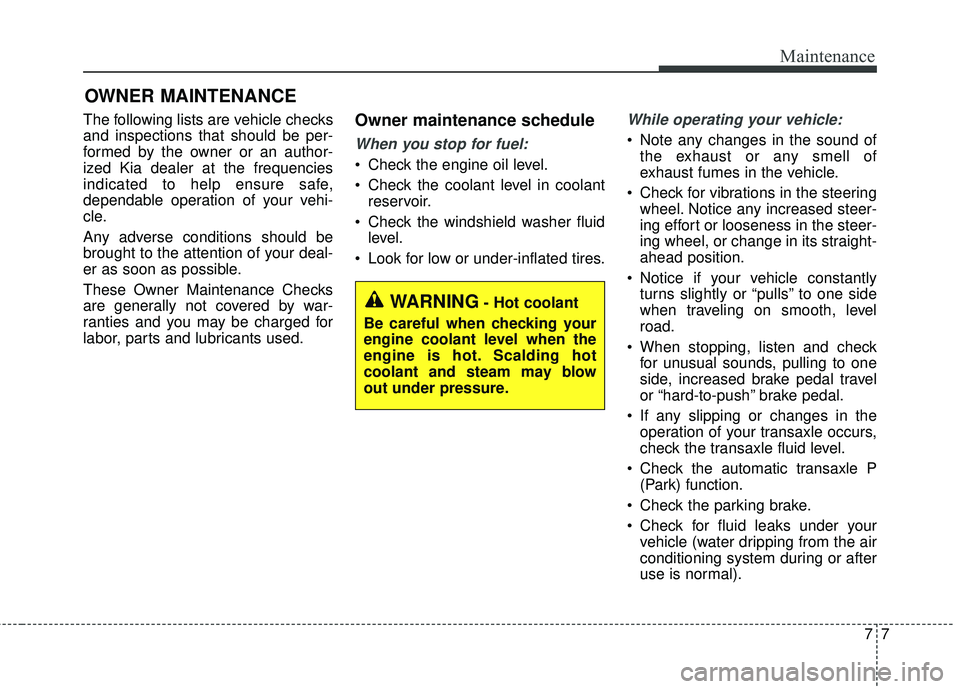
77
Maintenance
OWNER MAINTENANCE
The following lists are vehicle checks
and inspections that should be per-
formed by the owner or an author-
ized Kia dealer at the frequencies
indicated to help ensure safe,
dependable operation of your vehi-
cle.
Any adverse conditions should be
brought to the attention of your deal-
er as soon as possible.
These Owner Maintenance Checks
are generally not covered by war-
ranties and you may be charged for
labor, parts and lubricants used.Owner maintenance schedule
When you stop for fuel:
Check the engine oil level.
Check the coolant level in coolantreservoir.
Check the windshield washer fluid level.
Look for low or under-inflated tires.
While operating your vehicle:
Note any changes in the sound of the exhaust or any smell of
exhaust fumes in the vehicle.
Check for vibrations in the steering wheel. Notice any increased steer-
ing effort or looseness in the steer-
ing wheel, or change in its straight-
ahead position.
Notice if your vehicle constantly turns slightly or “pulls” to one side
when traveling on smooth, level
road.
When stopping, listen and check for unusual sounds, pulling to one
side, increased brake pedal travel
or “hard-to-push” brake pedal.
If any slipping or changes in the operation of your transaxle occurs,
check the transaxle fluid level.
Check the automatic transaxle P (Park) function.
Check the parking brake.
Check for fluid leaks under your vehicle (water dripping from the air
conditioning system during or after
use is normal).
WARNING- Hot coolant
Be careful when checking your
engine coolant level when the
engine is hot. Scalding hot
coolant and steam may blow
out under pressure.
Page 488 of 584
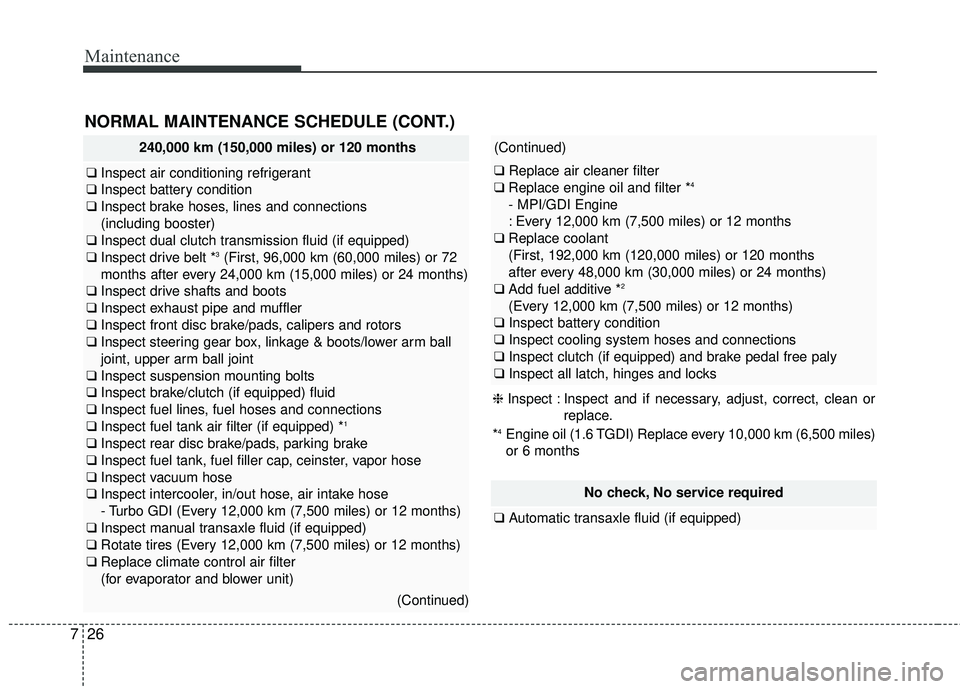
Maintenance
26
7
(Continued)
❑ Replace air cleaner filter
❑ Replace engine oil and filter *4
- MPI/GDI Engine
: Every 12,000 km (7,500 miles) or 12 months
❑ Replace coolant
(First, 192,000 km (120,000 miles) or 120 months
after every 48,000 km (30,000 miles) or 24 months)
❑ Add fuel additive *
2
(Every 12,000 km (7,500 miles) or 12 months)
❑ Inspect battery condition
❑ Inspect cooling system hoses and connections
❑ Inspect clutch (if equipped) and brake pedal free paly
❑ Inspect all latch, hinges and locks
❈ Inspect : Inspect and if necessary, adjust, correct, clean or
replace.
*
4Engine oil (1.6 TGDI) Replace every 10,000 km (6,500 miles)
or 6 months
NORMAL MAINTENANCE SCHEDULE (CONT.)
240,000 km (150,000 miles) or 120 months
❑ Inspect air conditioning refrigerant
❑ Inspect battery condition
❑ Inspect brake hoses, lines and connections
(including booster)
❑ Inspect dual clutch transmission fluid (if equipped)
❑ Inspect drive belt *
3 (First, 96,000 km (60,000 miles) or 72
months after every 24,000 km (15,000 miles) or 24 months)
❑ Inspect drive shafts and boots
❑ Inspect exhaust pipe and muffler
❑ Inspect front disc brake/pads, calipers and rotors
❑ Inspect steering gear box, linkage & boots/lower arm ball
joint, upper arm ball joint
❑ Inspect suspension mounting bolts
❑ Inspect brake/clutch (if equipped) fluid
❑ Inspect fuel lines, fuel hoses and connections
❑ Inspect fuel tank air filter (if equipped) *
1
❑Inspect rear disc brake/pads, parking brake
❑ Inspect fuel tank, fuel filler cap, ceinster, vapor hose
❑ Inspect vacuum hose
❑ Inspect intercooler, in/out hose, air intake hose
- Turbo GDI (Every 12,000 km (7,500 miles) or 12 months)
❑ Inspect manual transaxle fluid (if equipped)
❑ Rotate tires (Every 12,000 km (7,500 miles) or 12 months)
❑ Replace climate control air filter
(for evaporator and blower unit)
(Continued)
No check, No service required
❑ Automatic transaxle fluid (if equipped)
Page 491 of 584
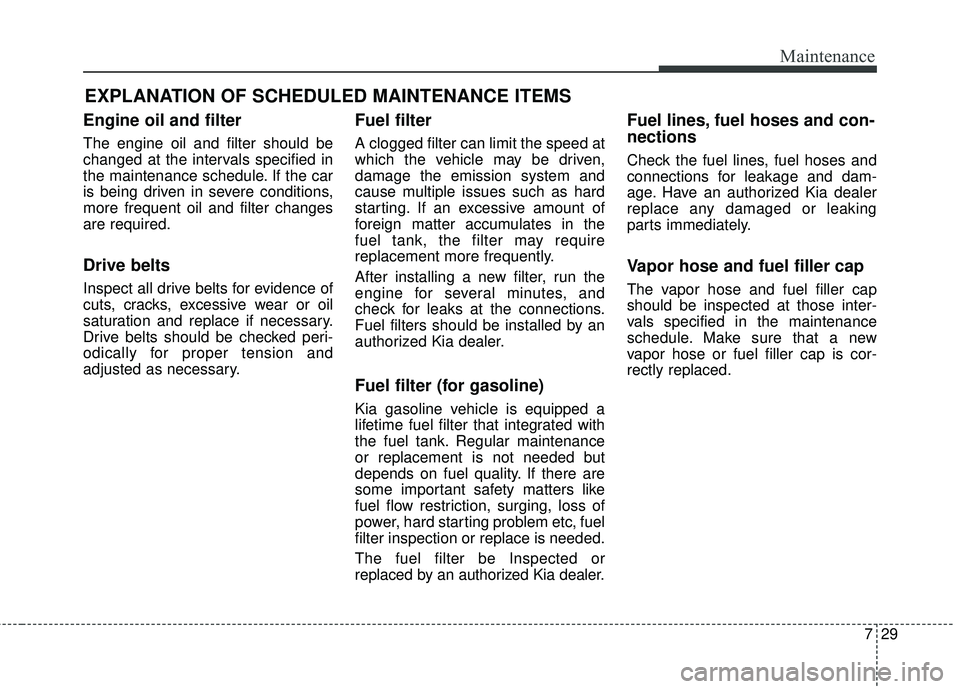
729
Maintenance
EXPLANATION OF SCHEDULED MAINTENANCE ITEMS
Engine oil and filter
The engine oil and filter should be
changed at the intervals specified in
the maintenance schedule. If the car
is being driven in severe conditions,
more frequent oil and filter changes
are required.
Drive belts
Inspect all drive belts for evidence of
cuts, cracks, excessive wear or oil
saturation and replace if necessary.
Drive belts should be checked peri-
odically for proper tension and
adjusted as necessary.
Fuel filter
A clogged filter can limit the speed at
which the vehicle may be driven,
damage the emission system and
cause multiple issues such as hard
starting. If an excessive amount of
foreign matter accumulates in the
fuel tank, the filter may require
replacement more frequently.
After installing a new filter, run the
engine for several minutes, and
check for leaks at the connections.
Fuel filters should be installed by an
authorized Kia dealer.
Fuel filter (for gasoline)
Kia gasoline vehicle is equipped a
lifetime fuel filter that integrated with
the fuel tank. Regular maintenance
or replacement is not needed but
depends on fuel quality. If there are
some important safety matters like
fuel flow restriction, surging, loss of
power, hard starting problem etc, fuel
filter inspection or replace is needed.
The fuel filter be Inspected or
replaced by an authorized Kia dealer.
Fuel lines, fuel hoses and con-
nections
Check the fuel lines, fuel hoses and
connections for leakage and dam-
age. Have an authorized Kia dealer
replace any damaged or leaking
parts immediately.
Vapor hose and fuel filler cap
The vapor hose and fuel filler cap
should be inspected at those inter-
vals specified in the maintenance
schedule. Make sure that a new
vapor hose or fuel filler cap is cor-
rectly replaced.
Page 494 of 584
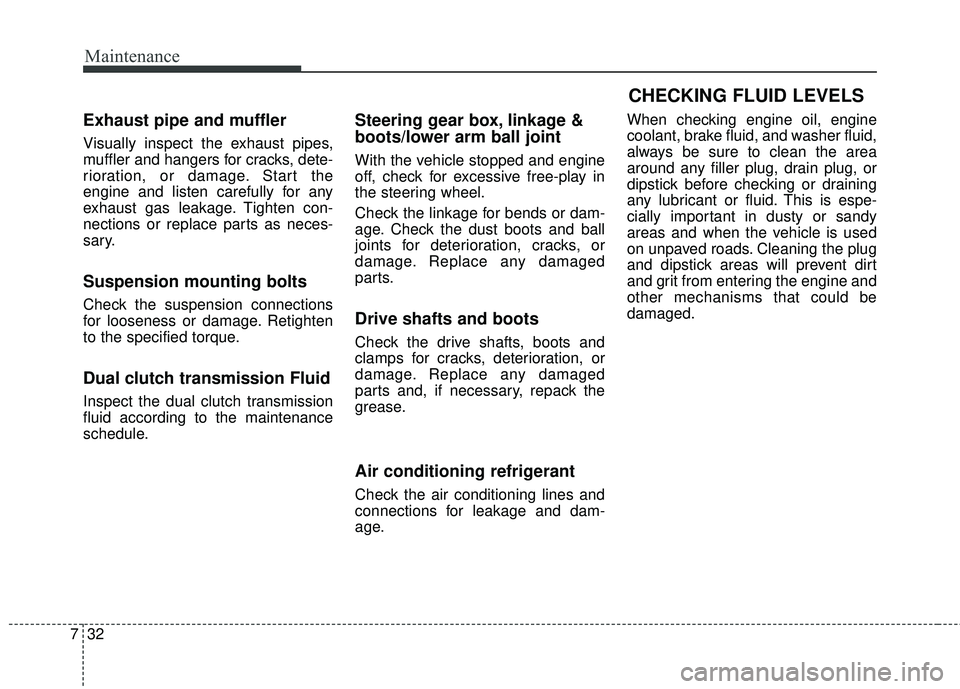
Maintenance
32
7
Exhaust pipe and muffler
Visually inspect the exhaust pipes,
muffler and hangers for cracks, dete-
rioration, or damage. Start the
engine and listen carefully for any
exhaust gas leakage. Tighten con-
nections or replace parts as neces-
sary.
Suspension mounting bolts
Check the suspension connections
for looseness or damage. Retighten
to the specified torque.
Dual clutch transmission Fluid
Inspect the dual clutch transmission
fluid according to the maintenance
schedule.
Steering gear box, linkage &
boots/lower arm ball joint
With the vehicle stopped and engine
off, check for excessive free-play in
the steering wheel.
Check the linkage for bends or dam-
age. Check the dust boots and ball
joints for deterioration, cracks, or
damage. Replace any damaged
parts.
Drive shafts and boots
Check the drive shafts, boots and
clamps for cracks, deterioration, or
damage. Replace any damaged
parts and, if necessary, repack the
grease.
Air conditioning refrigerant
Check the air conditioning lines and
connections for leakage and dam-
age. When checking engine oil, engine
coolant, brake fluid, and washer fluid,
always be sure to clean the area
around any filler plug, drain plug, or
dipstick before checking or draining
any lubricant or fluid. This is espe-
cially important in dusty or sandy
areas and when the vehicle is used
on unpaved roads. Cleaning the plug
and dipstick areas will prevent dirt
and grit from entering the engine and
other mechanisms that could be
damaged.
CHECKING FLUID LEVELS
Page 495 of 584
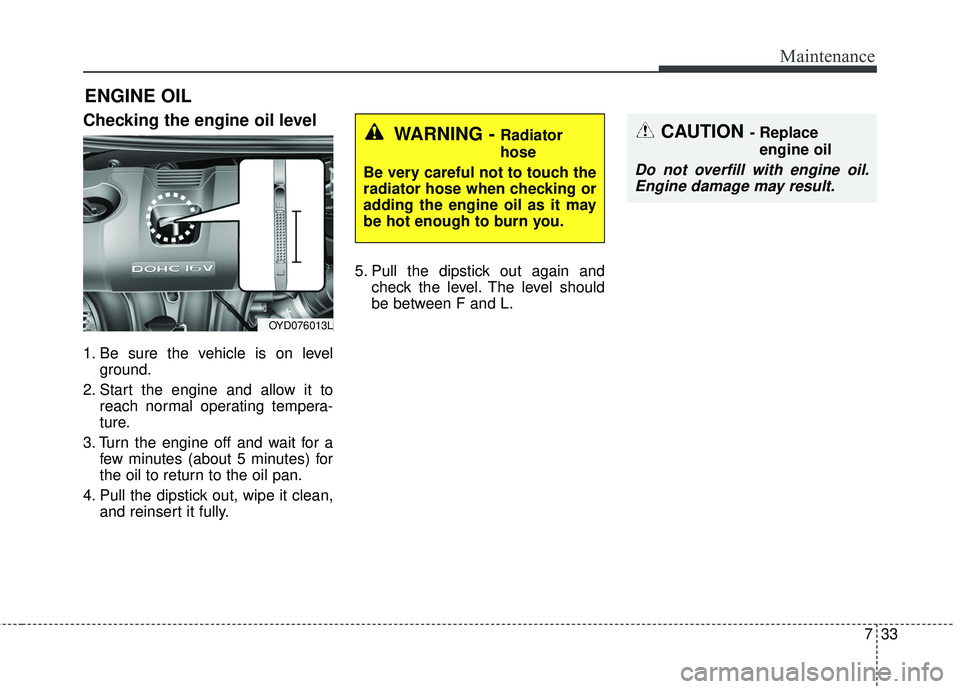
733
Maintenance
ENGINE OIL
Checking the engine oil level
1. Be sure the vehicle is on levelground.
2. Start the engine and allow it to reach normal operating tempera-
ture.
3. Turn the engine off and wait for a few minutes (about 5 minutes) for
the oil to return to the oil pan.
4. Pull the dipstick out, wipe it clean, and reinsert it fully. 5. Pull the dipstick out again and
check the level. The level should
be between F and L.
WARNING - Radiator
hose
Be very careful not to touch the
radiator hose when checking or
adding the engine oil as it may
be hot enough to burn you.CAUTION - Replace engine oil
Do not overfill with engine oil.Engine damage may result.
OYD076013L
Page 500 of 584
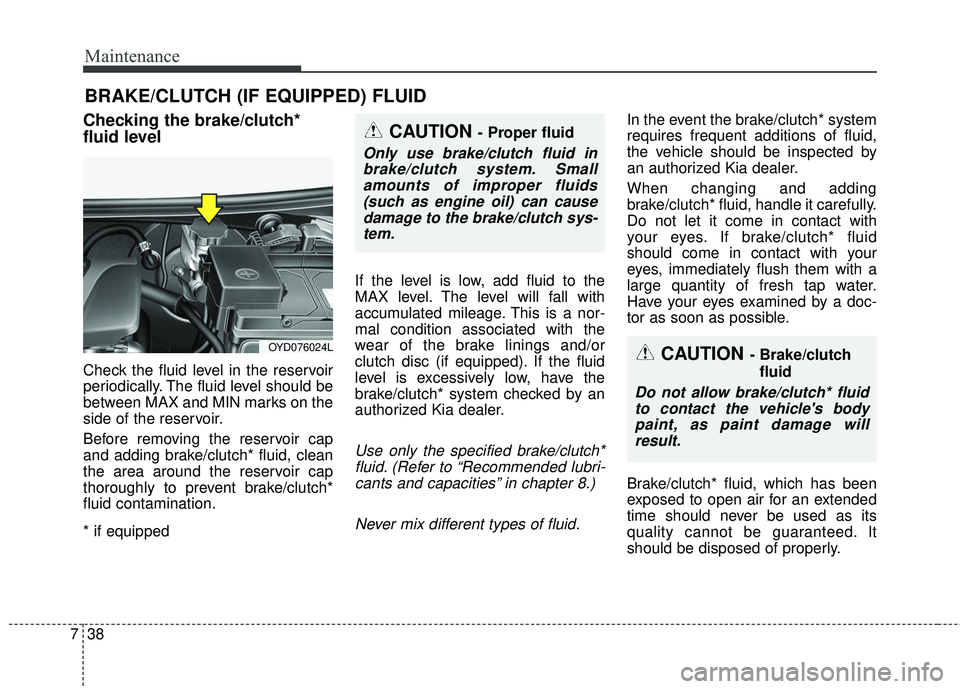
Maintenance
38
7
BRAKE/CLUTCH (IF EQUIPPED) FLUID
Checking the brake/clutch*
fluid level
Check the fluid level in the reservoir
periodically. The fluid level should be
between MAX and MIN marks on the
side of the reservoir.
Before removing the reservoir cap
and adding brake/clutch* fluid, clean
the area around the reservoir cap
thoroughly to prevent brake/clutch*
fluid contamination.
* if equipped If the level is low, add fluid to the
MAX level. The level will fall with
accumulated mileage. This is a nor-
mal condition associated with the
wear of the brake linings and/or
clutch disc (if equipped). If the fluid
level is excessively low, have the
brake/clutch* system checked by an
authorized Kia dealer.
Use only the specified brake/clutch*
fluid. (Refer to “Recommended lubri-cants and capacities” in chapter 8.)
Never mix different types of fluid.
In the event the brake/clutch* system
requires frequent additions of fluid,
the vehicle should be inspected by
an authorized Kia dealer.
When changing and adding
brake/clutch* fluid, handle it carefully.
Do not let it come in contact with
your eyes. If brake/clutch* fluid
should come in contact with your
eyes, immediately flush them with a
large quantity of fresh tap water.
Have your eyes examined by a doc-
tor as soon as possible.
Brake/clutch* fluid, which has been
exposed to open air for an extended
time should never be used as its
quality cannot be guaranteed. It
should be disposed of properly.
CAUTION - Brake/clutch fluid
Do not allow brake/clutch* fluidto contact the vehicle's bodypaint, as paint damage willresult.
CAUTION - Proper fluid
Only use brake/clutch fluid inbrake/clutch system. Smallamounts of improper fluids(such as engine oil) can causedamage to the brake/clutch sys-tem.
OYD076024L
Page 511 of 584
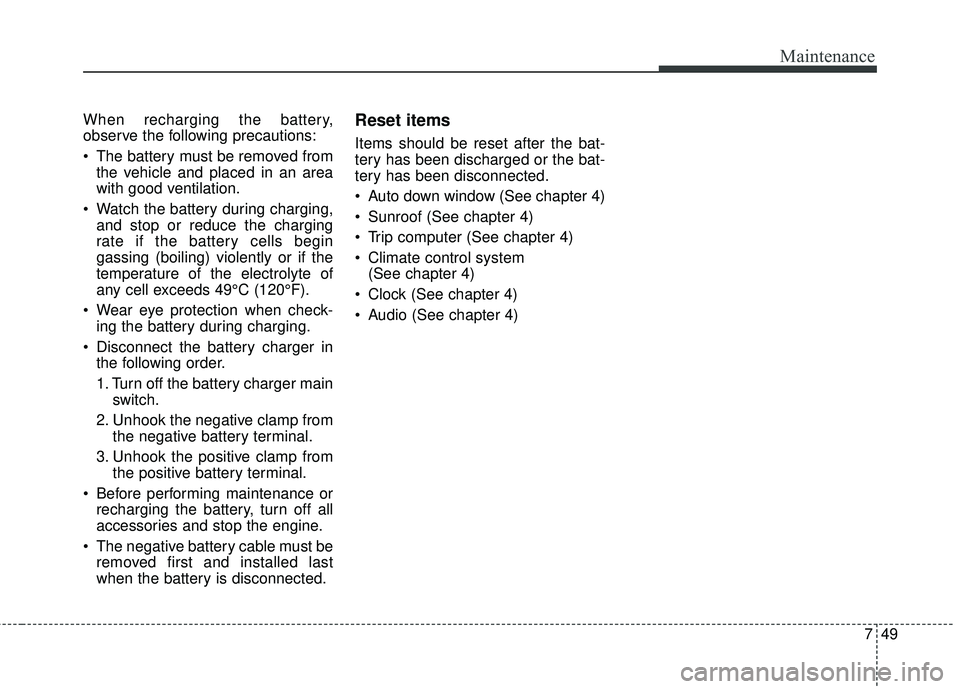
749
Maintenance
When recharging the battery,
observe the following precautions:
The battery must be removed fromthe vehicle and placed in an area
with good ventilation.
Watch the battery during charging, and stop or reduce the charging
rate if the battery cells begin
gassing (boiling) violently or if the
temperature of the electrolyte of
any cell exceeds 49°C (120°F).
Wear eye protection when check- ing the battery during charging.
Disconnect the battery charger in the following order.
1. Turn off the battery charger main switch.
2. Unhook the negative clamp from the negative battery terminal.
3. Unhook the positive clamp from the positive battery terminal.
Before performing maintenance or recharging the battery, turn off all
accessories and stop the engine.
The negative battery cable must be removed first and installed last
when the battery is disconnected.Reset items
Items should be reset after the bat-
tery has been discharged or the bat-
tery has been disconnected.
Auto down window (See chapter 4)
Sunroof (See chapter 4)
Trip computer (See chapter 4)
Climate control system (See chapter 4)
Clock (See chapter 4)
Audio (See chapter 4)
Page 526 of 584
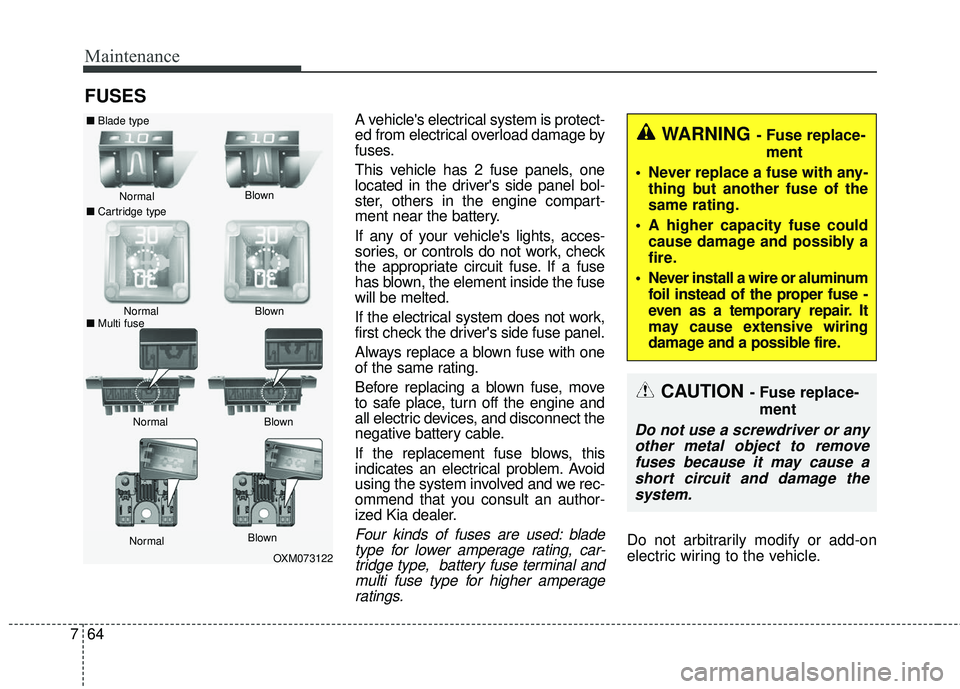
Maintenance
64
7
FUSES
A vehicle's electrical system is protect-
ed from electrical overload damage by
fuses.
This vehicle has 2 fuse panels, one
located in the driver's side panel bol-
ster, others in the engine compart-
ment near the battery.
If any of your vehicle's lights, acces-
sories, or controls do not work, check
the appropriate circuit fuse. If a fuse
has blown, the element inside the fuse
will be melted.
If the electrical system does not work,
first check the driver's side fuse panel.
Always replace a blown fuse with one
of the same rating.
Before replacing a blown fuse, move
to safe place, turn off the engine and
all electric devices, and disconnect the
negative battery cable.
If the replacement fuse blows, this
indicates an electrical problem. Avoid
using the system involved and we rec-
ommend that you consult an author-
ized Kia dealer.
Four kinds of fuses are used: blade
type for lower amperage rating, car-tridge type, battery fuse terminal andmulti fuse type for higher amperageratings.Do not arbitrarily modify or add-on
electric wiring to the vehicle.
WARNING - Fuse replace-
ment
Never replace a fuse with any- thing but another fuse of the
same rating.
A higher capacity fuse could cause damage and possibly a
fire.
Never install a wire or aluminum foil instead of the proper fuse -
even as a temporary repair. It
may cause extensive wiring
damage and a possible fire.
CAUTION - Fuse replace-
ment
Do not use a screwdriver or anyother metal object to removefuses because it may cause ashort circuit and damage thesystem.
OXM073122
Normal
Normal
■
Blade type
■ Cartridge type
■ Multi fuse Blown
Blown
Normal Blown
Normal Blown
Page 579 of 584
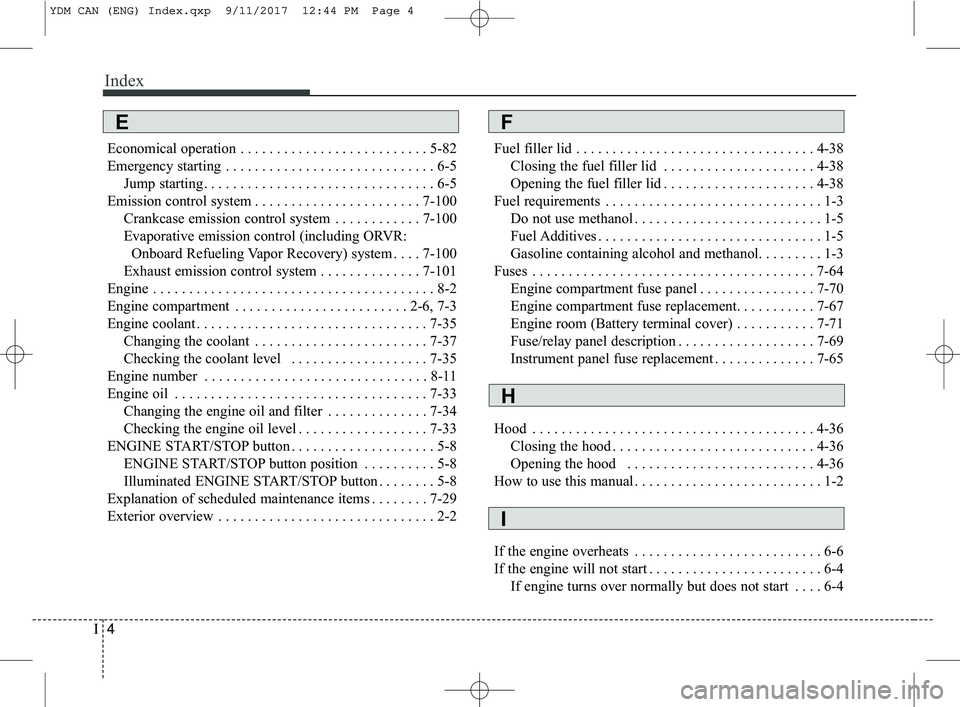
Index
4I
Economical operation . . . . . . . . . . . . . . . . . . . . . . . . . . 5-82
Emergency starting . . . . . . . . . . . . . . . . . . . . . . . . . . . . . 6-5Jump starting. . . . . . . . . . . . . . . . . . . . . . . . . . . . . . . . 6-5
Emission control system . . . . . . . . . . . . . . . . . . . . . . . 7-100 Crankcase emission control system . . . . . . . . . . . . 7-100
Evaporative emission control (including ORVR: Onboard Refueling Vapor Recovery) system . . . . 7-100
Exhaust emission control system . . . . . . . . . . . . . . 7-101
Engine . . . . . . . . . . . . . . . . . . . . . . . . . . . . . . . . . . . . \
. . . 8-2
Engine compartment . . . . . . . . . . . . . . . . . . . . . . . . 2-6, 7-3
Engine coolant . . . . . . . . . . . . . . . . . . . . . . . . . . . . . . . . 7-35 Changing the coolant . . . . . . . . . . . . . . . . . . . . . . . . 7-37
Checking the coolant level . . . . . . . . . . . . . . . . . . . 7-35
Engine number . . . . . . . . . . . . . . . . . . . . . . . . . . . . . . . 8-11
Engine oil . . . . . . . . . . . . . . . . . . . . . . . . . . . . . . . . . . . 7-\
33 Changing the engine oil and filter . . . . . . . . . . . . . . 7-34
Checking the engine oil level . . . . . . . . . . . . . . . . . . 7-33
ENGINE START/STOP button . . . . . . . . . . . . . . . . . . . . 5-8 ENGINE START/STOP button position . . . . . . . . . . 5-8
Illuminated ENGINE START/STOP button . . . . . . . . 5-8
Explanation of scheduled maintenance items . . . . . . . . 7-29
Exterior overview . . . . . . . . . . . . . . . . . . . . . . . . . . . . . . 2-2 Fuel filler lid . . . . . . . . . . . . . . . . . . . . . . . . . . . . . . . . . 4-38
Closing the fuel filler lid . . . . . . . . . . . . . . . . . . . . . 4-38
Opening the fuel filler lid . . . . . . . . . . . . . . . . . . . . . 4-38
Fuel requirements . . . . . . . . . . . . . . . . . . . . . . . . . . . . . . 1-3 Do not use methanol . . . . . . . . . . . . . . . . . . . . . . . . . . 1-5
Fuel Additives . . . . . . . . . . . . . . . . . . . . . . . . . . . . . . . 1-5
Gasoline containing alcohol and methanol. . . . . . . . . 1-3
Fuses . . . . . . . . . . . . . . . . . . . . . . . . . . . . . . . . . . . . \
. . . 7-64 Engine compartment fuse panel . . . . . . . . . . . . . . . . 7-70
Engine compartment fuse replacement. . . . . . . . . . . 7-67
Engine room (Battery terminal cover) . . . . . . . . . . . 7-71
Fuse/relay panel description . . . . . . . . . . . . . . . . . . . 7-69
Instrument panel fuse replacement . . . . . . . . . . . . . . 7-65
Hood . . . . . . . . . . . . . . . . . . . . . . . . . . . . . . . . . . . . \
. . . 4-36 Closing the hood . . . . . . . . . . . . . . . . . . . . . . . . . . . . 4-36
Opening the hood . . . . . . . . . . . . . . . . . . . . . . . . . . 4-36
How to use this manual . . . . . . . . . . . . . . . . . . . . . . . . . . 1-2
If the engine overheats . . . . . . . . . . . . . . . . . . . . . . . . . . 6-6
If the engine will not start . . . . . . . . . . . . . . . . . . . . . . . . 6-4 If engine turns over normally but does not start . . . . 6-4
EF
H
I
YDM CAN (ENG) Index.qxp 9/11/2017 12:44 PM Page 4
Page 584 of 584
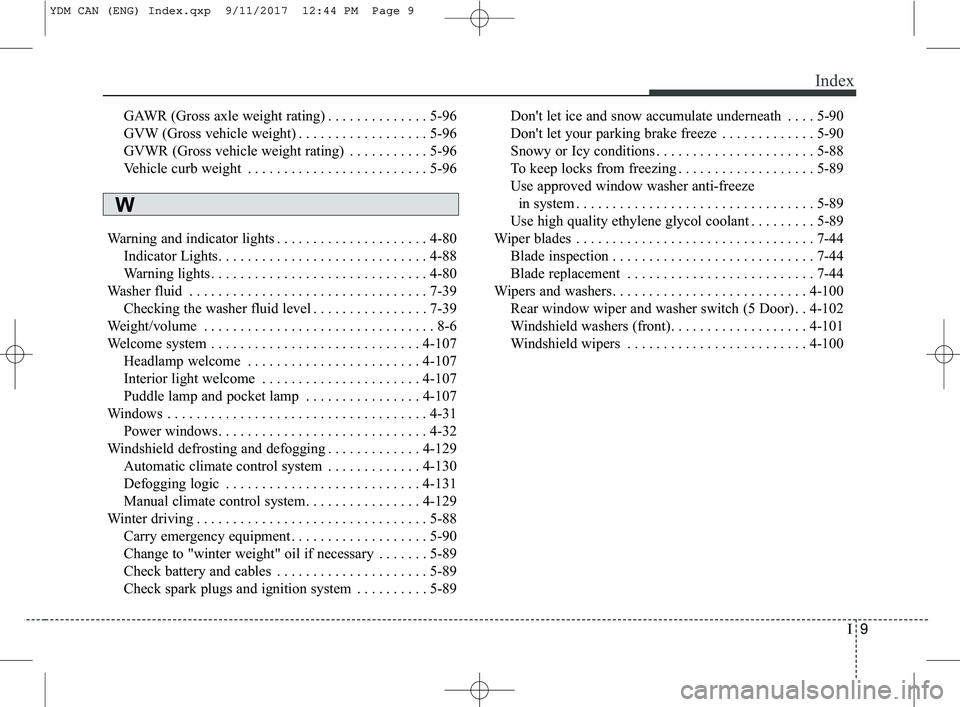
I9
Index
GAWR (Gross axle weight rating) . . . . . . . . . . . . . . 5-96
GVW (Gross vehicle weight) . . . . . . . . . . . . . . . . . . 5-96
GVWR (Gross vehicle weight rating) . . . . . . . . . . . 5-96
Vehicle curb weight . . . . . . . . . . . . . . . . . . . . . . . . . 5-96
Warning and indicator lights . . . . . . . . . . . . . . . . . . . . . 4-80 Indicator Lights. . . . . . . . . . . . . . . . . . . . . . . . . . . . . 4-88
Warning lights . . . . . . . . . . . . . . . . . . . . . . . . . . . . . . 4-80
Washer fluid . . . . . . . . . . . . . . . . . . . . . . . . . . . . . . . . . 7-39 Checking the washer fluid level . . . . . . . . . . . . . . . . 7-39
Weight/volume . . . . . . . . . . . . . . . . . . . . . . . . . . . . . . . . 8-6
Welcome system . . . . . . . . . . . . . . . . . . . . . . . . . . . . . 4-107 Headlamp welcome . . . . . . . . . . . . . . . . . . . . . . . . 4-107
Interior light welcome . . . . . . . . . . . . . . . . . . . . . . 4-107
Puddle lamp and pocket lamp . . . . . . . . . . . . . . . . 4-107
Windows . . . . . . . . . . . . . . . . . . . . . . . . . . . . . . . . . . . . \
4-31 Power windows. . . . . . . . . . . . . . . . . . . . . . . . . . . . . 4-32
Windshield defrosting and defogging . . . . . . . . . . . . . 4-129 Automatic climate control system . . . . . . . . . . . . . 4-130
Defogging logic . . . . . . . . . . . . . . . . . . . . . . . . . . . 4-131
Manual climate control system . . . . . . . . . . . . . . . . 4-129
Winter driving . . . . . . . . . . . . . . . . . . . . . . . . . . . . . . . . 5-88 Carry emergency equipment . . . . . . . . . . . . . . . . . . . 5-90
Change to "winter weight" oil if necessary . . . . . . . 5-89
Check battery and cables . . . . . . . . . . . . . . . . . . . . . 5-89
Check spark plugs and ignition system . . . . . . . . . . 5-89 Don't let ice and snow accumulate underneath . . . . 5-90
Don't let your parking brake freeze . . . . . . . . . . . . . 5-90
Snowy or Icy conditions . . . . . . . . . . . . . . . . . . . . . . 5-88
To keep locks from freezing . . . . . . . . . . . . . . . . . . . 5-89
Use approved window washer anti-freeze in system . . . . . . . . . . . . . . . . . . . . . . . . . . . . . . . . . 5-89
Use high quality ethylene glycol coolant . . . . . . . . . 5-89
Wiper blades . . . . . . . . . . . . . . . . . . . . . . . . . . . . . . . . . 7-44 Blade inspection . . . . . . . . . . . . . . . . . . . . . . . . . . . . 7-44
Blade replacement . . . . . . . . . . . . . . . . . . . . . . . . . . 7-44
Wipers and washers . . . . . . . . . . . . . . . . . . . . . . . . . . . 4-100 Rear window wiper and washer switch (5 Door) . . 4-102
Windshield washers (front). . . . . . . . . . . . . . . . . . . 4-101
Windshield wipers . . . . . . . . . . . . . . . . . . . . . . . . . 4-100
W
YDM CAN (ENG) Index.qxp 9/11/2017 12:44 PM Page 9